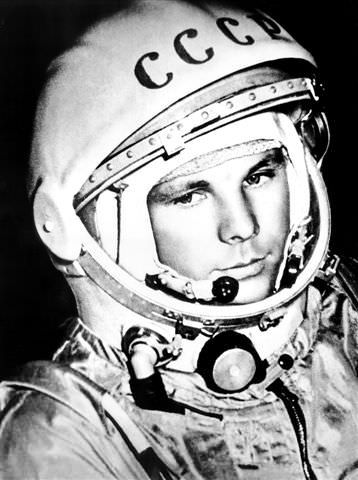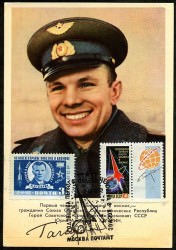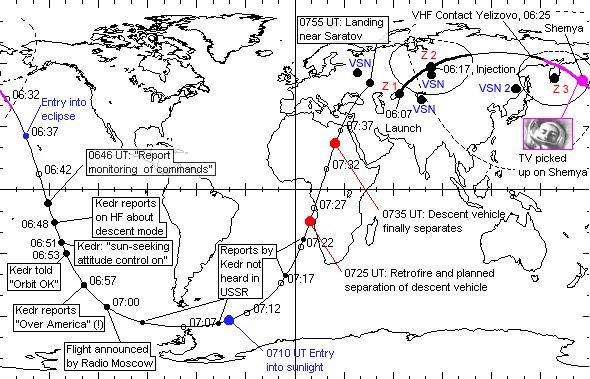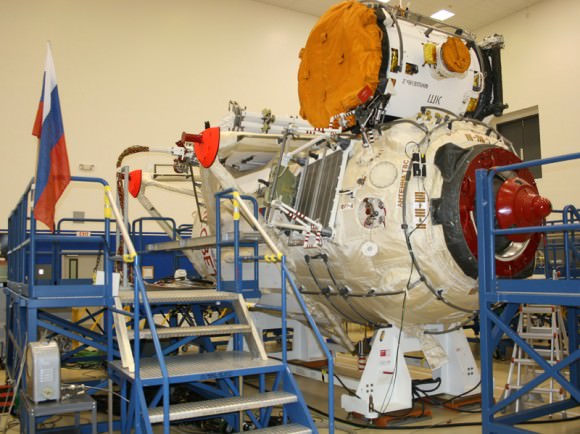
On April 12, 1961, Russian cosmonaut Yuri Gagarin (left, on the way to the launch pad) became the first human in space, making a 108-minute orbital flight in his Vostok 1 spacecraft.
Newspapers like The Huntsville Times (right) trumpeted Gagarin's accomplishment.
Credit: NASA
Send Ken your Yuri’s Night event reports and photos
Mark your calendars. April 12, 2011 marks the 50th Anniversary of Human Spaceflight and Cosmonaut Yuri Gagarin’s astonishing First Orbit of our precious planet Earth on April 12, 1961. Gagarin was the first human to enter outer space and see what no one else had ever witnessed – our commonly shared Earth as a planet and beautiful blue globe with no borders.
Space enthusiasts worldwide are celebrating this watershed moment in Human history at a network of over 400 “Yuri’s Night” parties taking place in more than 70 countries on 6 continents and 2 worlds, according to the official “Yuri’s Night” website.
Gagarin’s flight took place in the midst of the inflammatory Cold War rivalry between the Soviet Union and the United States and shocked the world into new realities. The Space Race led to the first lunar landing by the United States and Neil Armstrong’s first steps on the moons surface in 1969. Eventually, the world’s superpowers beat swords into plowshares and united their efforts to build the International Space Station.

Gagarin flew around the Earth in a single orbit at an altitude of 302 kilometers (187 miles). The flight lasted 108 minutes and safely ended when he descended back and parachuted to the ground, just north of the Caspian Sea. At the age of 27, Gagarin was instantly transformed into a worldwide hero. After the momentous flight he soon embarked on an international tour.
20 years later on April 12, 1981, NASA’s first space shuttle blasted off on the STS-1 mission on a daring test flight with astronauts John Young and Bob Crippen strapped inside Space Shuttle Columbia.

The first “Yuri’s Night – World Space Party” was held on April 12, 2001 to commemorate the 40th anniversary of Gagarin’s spaceflight. Over 10,000 people attended 64 events located worldwide. The goal was to inspire people, increase awareness and support for space exploration across the globe and foster the spread of new ideas to broaden our access to space.
“Yuri’s Night” has been growing in popularity every year. Events range in size from a few folks to numbers in the thousands. Attendees range from astronauts and cosmonauts, NASA and global space agency officials and reps, scientists and engineers, famous actors, playwrights, writers, artists, athletes and musicians to just everyday folks and kids of all ages and backgrounds. Everyone can get involved.

“First Orbit” recreates much of the view of the Earth’s surface that Gagarin would have seen fifty years ago. Mostly he flew over the world oceans as well as the Soviet Union and Africa.
Riley collaborated with the astronauts aboard the International Space Station, chiefly Paolo Nespoli of ESA, who took film footage from the new 7 windowed Cupola as the station matched the actual flight path of Gagarin and Vostok 1 as closely as possible. The free film celebrates 50 years of human spaceflight.
“First Orbit” premiers worldwide on YouTube in a special global streaming event for Yuri’s Night on April 12 . Watch the short trailer below, with original and stirring music by Philip Sheppard.

Gagarin’s call sign was Cedar or Kder - which means Siberian Pine in Russian. Map courtesy of Sven Grahn
It’s easy and free to register your local party at the Yuri’s Night event website. There is still time to register your Yuri’s Night party – Indeed the list has grown as I typed out this story !
Some events are already set to kick off this weekend. I’ll be presenting at an interactive and free Yuri’s Night evening event in Princeton Junction, New Jersey, about Gagarin’s flight and my experiences with the space shuttle and what‘s beyond.
Send Ken your “Yuri’s Night” event photos/short report to post in a round up story at Universe Today about the global festivities celebrating the historic achievement of Yuri Gagarin. Email kremerken at yahoo dot com
First Orbit Trailer II

Shuttle Atlantis delivered MRM-1 (known as Rassvet) to the International Space Station.
MRM-1 undergoes final prelaunch processing inside clean room at Astrotech Space Operations Facility in Florida. Docking port to ISS is protected by red colored covering. Equipment airlock for experiments at top. Russian Flag mounted at left.
Rassvet underscores the cooperation that exists today, in stark contrast to their rivalry during the Cold War. Russia, the United States, Europe, Japan and Canada have now united their space exploration efforts to build the International Space Station. The worlds space powers cooperate in other space exploration projects today as well that venture to the Moon, Mars and beyond to Deep Space. Credit: Ken Kremer
Read Ken’s other stories about Yuri Gagarin and Yuri’s Night:
Yuri Gagarin and Vostok 1 Photo Album – 50th Anniversary of Human Spaceflight
Stirring Video Tributes to Yuri Gagarin
Yuri’s Night Website
Yuri’s Night Party list
Yuri’s Night Party with Ken in Princeton Junction, NJ, USA
First Orbit Website
STS-1 NASA Mission Website
Ken Kremer


What a guy Gagarin turned out to be! Considering the background before the launch at the dangers and real possibility of catastrophic failure, he was very brave and resolute.
I’m surprised this article does not also mention the declassified documents of the technical hitches that plagued the first man to orbit the Earth. According to the SMH (among others);
Worst was that;
They said in this same article on the possibility of an accident that;
I think the celebration worldwide regardless of your political affiliations or ideologies. Discard the needless propaganda for a moment. Anyone who is brave enough to attempt such a flight into the unknown, knowing full well of the real possibility of not completing it. He and this launch of a man into space deserves our praise and sincere acknowledgement.
Note: Ken. You make the odd point that “20 years later on April 12, 1981… Space Shuttle Columbia” or Armstrong first landing on the moon. What has this to do with this landmark of this 50th Anniversary here?
We’ve come along way, sure, but for Man to finally leave the confines of the Earth and became a creature of the cosmos is one of the most profound changes in the so-called space age! It is not the American space age, or the Russian space age, is it? The space age itself marks human exploration beyond the Earth.
So perhaps in the next fifty years, all Americans can finally discard this old rivalry and instead join the whole world in humankind’s greatest and most important adventure. IMO, humanity’s future may actually depend on it!
Let us not forget that this man became an alcoholic and a womanizer and was probably eliminated by the Russian Space system to save face.
Nice one. So when should we mark the anniversary of the space age. Glenn, Armstrong, Bugs Bunny?
Have you ever considered why he might have taken up alcohol and women? The dear man after the mission was idolised and worshipped as a Soviet hero. The sheer pressure of all the fame and glory got to him in the end. It is well documented. (Why do you think Neil Armstrong dropped out so quickly and well away from the public eye, Eh?)
After a few hours stewing over just this one comment, all I can say is really despicable comments like this one are well beyond disgusting. Self-indulgent prigs like this filthy individual here deserve our utter condemnation.
To hell with you, sir!
Apparently DrBingle has never read Tom Wolf’s “The Right Stuff”.
With the exception of John Glenn, apparently all the remaining six Mercury astronauts took advantage of their own notoriety regarding relations with women they were not married to. Glenn’s reputation at being a “goody two-shoes” grated on the other astronauts.
We’re talking about “fighter jocks”..Men who’d all seen friends “auger in”.
Add to that Gagarin being thrust into the position of becoming the Soviet Union’s “poster boy” and the fact that he couldn’t save his friend Vladimir Komarov from the doomed Soyuz I mission and you get a very conflicted personality. Komarov had even refused to back out of the mission he knew would kill him because Gagarin was the back-up and he didn’t want to see his friend and national hero die – so he sacrificed himself. Gagarin raised such a stink with the higher-ups he was told to “shut up and just be a hero”. And was never allowed to train for another space flight.
Gagarin was a man with deep problems brought about by the system that held him up as an example the “new Soviet man”, but wanted to “embalm” him while still living as an icon of Soviet superiority. He wasn’t even used for that purpose after Komarov’s death. So we had a cosmonaut who was no longer permitted to do what he wanted to do most who’d been shunted off to a personal Siberia. It’s no wonder his character flaws came to the surface.
Dismissing Gagarin for his disease and his weaknesses brought on by the pressures he experienced after his space flight does an incredible disservice.
History shows numerous examples of people who have been thrust into the limelight as heroes, but who were painfully aware of their own faults as human beings.
Let’s not glorify manned spaceflight without a moment of silence for the pioneers who came before.
Lost Cosmonauts – Wikipedia, the free encyclopedia
http://en.wikipedia.org/wiki/Lost_Cosmonauts
Most importantly we must not let sacrifices of space flight be in vain!
I’m sure many readers have pondered a time when we could be stuck on Earth, never to bloom into a space fairing life form! After all, Earth will not be here forever.
I feel a sense of urgency.
E
What is there to remember here? “The evidence cited to support Lost Cosmonaut theories is generally not regarded as conclusive, and several cases have been confirmed as hoaxes.”
The well known but unfortunate tendency of humans to make shit up for various reasons is nothing to celebrate. It makes me truly sad that it should be mentioned alongside remembrance of actual people doing dangerous deeds, lessening the import of that.
Really? Does it lessen the import, or strengthen it? Think about that.
No. it makes you respectful of others, something that has been lost by some in the last 50 years. Pity.
Here, am I floating in a tin can, far above the world. Planet Earth is blue, and there’s nothing I can do……
Tin can / Trash can. The disease he had was communism. Fly in this POS or get shot. They needed a two seater so the commies could report on each other.
Just more bitter unappreciative piffle…
Thank you Russia for reminding us some people in this world are plain poor losers. May the next 50 years of the spage age be better for all the rest of us, even if you are an American or Russia!
Doh! May the next 50 years of the space age be better for all the rest of us, even if you are an American or Russia!